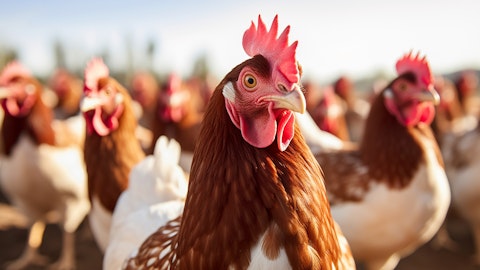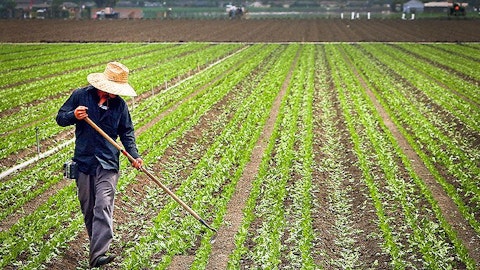Thilo Wrede: And then, Adam, on the broader cost picture, I think I alluded to it in the prepared remarks, right? We are seeing on soybean meal and corn costs decreasing year-over-year, so we do get a benefit from that. But from a gross margin perspective, that’s offset by the return of more normal trade spending and by some labor inflation. And then below the gross profit line, we are anticipating some increase in freight rates. Jury is out on that one. We hope to get some SG&A leverage, but there is a reinvestment in marketing spend. And so that is why we’re giving the guidance that we’re giving for the time being. You also asked about cash flow. So, CapEx, we’re giving the guidance of $35 million to $45 million of CapEx we’re anticipating so continued strong operating cash flow generation.
But compared to prior years, we’ll start putting more money into CapEx, as we have talked in the past. We’re getting started with the new facility this year. And Russell had mentioned it in the beginning that we’re starting now this digital transformation that will also require CapEx spending.
Adam Samuelson: Okay, that’s all very helpful. And just on that CapEx point, so you said $10 million was spend budgeted for 2023 that’s slipping into 2024. Can you just delineate how much of the rest is the ERP spending? And how much would be kind of Egg Central Station 3 at this point?
Thilo Wrede: Yes. The new facility and ERP spend is about half of what we are budgeting CapEx for and then there’s the regular ongoing CapEx plus some additional automation that we want to put into ECS.
Adam Samuelson: All right. That’s all super-helpful. I’ll pass it on. Thank you.
Russell Diez-Canseco: Thanks Adam.
Operator: Thank you. Our next question comes from the line of Matt Smith with Stifel. Your line is now open.
Matt Smith: Hi good morning. Let me ask a question. There was a comment in the prepared remarks about a pricing and promotional recalibration. Could you expand on that? Is that a recalibration in consideration to how you have viewed your promotional events in the past? Or is that more indicating that 2024, the recalibration is getting back to a normal cadence of promotional spending?
Thilo Wrede: It’s really the latter. If you recall last year, because of the high demand from AI and therefore, the empty shelfs that we saw, especially at the beginning of the year, we talked repeatedly about it last year that in the first half of the year, we were able to really meaningfully reduce our trade spend. And so about the prepared remarks were — remarks were supposed to indicate that this year, we are back to regular promotional spend throughout the year, focus on generating trial, getting new households into the brand. It’s not a recalibration of how we think about promotional spend overall. It’s more a 2023 was an outlier for us. We’re getting back to how we would have done it otherwise.
Matt Smith: Thank you. And a follow-up relating to the butter business. There was a significant decline in sales. I believe revenue was down over 30%, even including the benefit of the 53rd week. You indicated butter sales are expected to grow even though you are rationalizing some SKUs. Was there something unique in the fourth quarter related to that rationalization that weighed on the top line? And I can leave it there. Thanks so much.
Russell Diez-Canseco: Thank you. Yes, I’ll talk a little bit about how that business has evolved. You’ve heard me talk in prior calls about how we started that butter business years ago with aspirations to grow it to $20 million at the time, that was about the size of the egg business. As we have expanded that butter business beyond $20 million, what we found is that it is increasingly hard to find the right farms that meet our very high standards. And so that has affected our ability to grow that business. The demand is there, but we’re unwilling to procure butter and work with co-packers that we don’t love. And so what we’ve had to do is actually rethink our supply chain for butter and in essence, really transform it. And that transformation started in Q4, and we should be complete by the end of Q1.
But in the transition, we’ve faced some real strong product shortages that have limited our ability to fill orders. So, we’re expecting to see strong growth in the back half of the year. But for right now, we’re a bit challenged on the supply side.
Operator: Thank you. Our next question comes from the line of Rob Moskow with TD Cowen. Your line is now open.
Jacob Henry: Hey thanks for the question. This is Jacob Henry on for Rob Moskow. I saw a slide in your presentation on legislation changes in several states on laws around caged eggs. I’m just curious, are you noticing any change in conversations with retailers in these states, maybe a greater willingness to allocate more shelf space to ethically-sourced eggs?
Russell Diez-Canseco: Yes. Thanks for that question. I think it’s a great one. I think what we’ve seen historically and what we continue to see is that when these kinds of legislations go into effect, there is sometimes a temporary disruption or dislocation in the egg market as retailers need to adjust their forecasts for various items within their sets. And that can sometimes create a short-term, but probably temporary benefit for anybody whose product meets those new standards. So, we’re not seeing a substantial change in the interest of retailers to add our products to their shelves. And I think what we are seeing potentially from a short-term perspective is occasionally some elevated retail pricing for commodity or cage-free eggs that generally will smooth out in the months after the transition to that new regulation.


